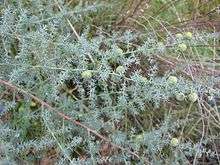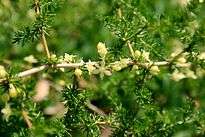Asparagus acutifolius
Asparagus acutifolius, common name wild asparagus, is an evergreen perennial plant belonging to the genus Asparagus. The specific epithet, acutifolius, meaning "thorny leaves", is derived from Latin acutus (pointed, acute), and -folius (-leaved), and refers to the characteristic shape of the leaves, a quite common feature in the typical plants of the Mediterranean.[1]
| Asparagus acutifolius | |
|---|---|
 | |
| Plant and berries of Asparagus acutifolius | |
| Scientific classification | |
| Kingdom: | Plantae |
| Clade: | Tracheophytes |
| Clade: | Angiosperms |
| Clade: | Monocots |
| Order: | Asparagales |
| Family: | Asparagaceae |
| Subfamily: | Asparagoideae |
| Genus: | Asparagus |
| Species: | A. acutifolius |
| Binomial name | |
| Asparagus acutifolius | |
| Synonyms | |
| |
Description
Asparagus acutifolius reaches on average 30–70 centimetres (12–28 in) of height. The stems have much-branched feathery foliage. The "leaves" are in fact needle-like modified stems. The flowers are bell-shaped and in small clusters, greenish-white to yellowish, 4.5–5.5 millimetres (0.18–0.22 in) long. The flowers are dioecious (on each plant they are only male or female). In some Mediterranean regions flowering occurs in late Summer from August through September, often after heavy storms. In this case the small green berries, of 5–6 millimetres (0.20–0.24 in) in diameter, are fully ripe in winter.
Gallery
 Plant and flowers of Asparagus acutifolius |
Branch of Asparagus acutifolius |
Bud of Asparagus acutifolius |
Flower of Asparagus acutifolius |
Distribution
This species is present throughout the Mediterranean Basin.
Habitat
These plants grow near woods and in uncultivated places, on dry and sunny soil. They can be found at an altitude of 0–1,300 metres (0–4,265 ft) above sea level.
References
- Eggli, Urs; Newton, Leonard E. (2004). Etymological Dictionary of Succulent Plant Names. Berlin, Heidelberg: Springer. p. 2. ISBN 978-3-540-00489-9. Retrieved 19 November 2018.
- Pignatti S. - Flora d'Italia – Edagricole – 1982 Vol. III. pg. 398